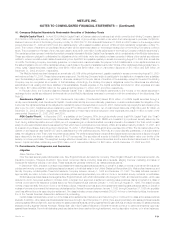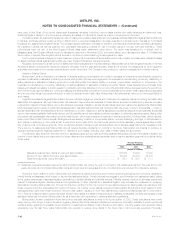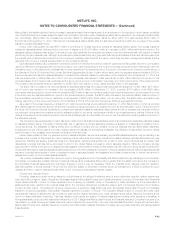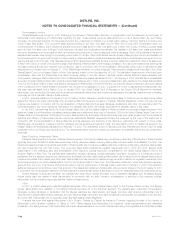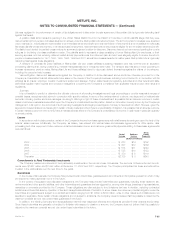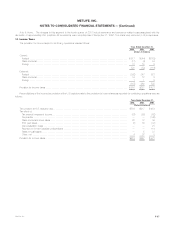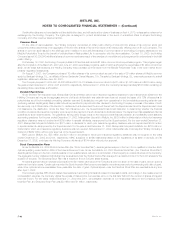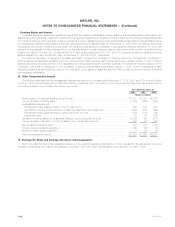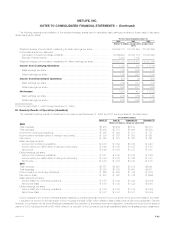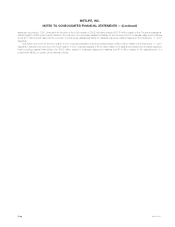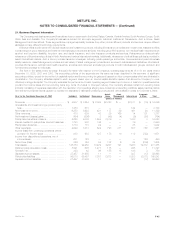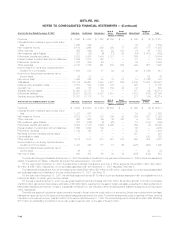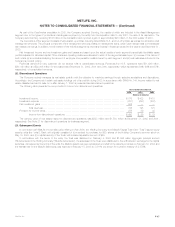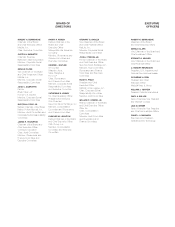MetLife 2002 Annual Report Download - page 84
Download and view the complete annual report
Please find page 84 of the 2002 MetLife annual report below. You can navigate through the pages in the report by either clicking on the pages listed below, or by using the keyword search tool below to find specific information within the annual report.METLIFE, INC.
NOTES TO CONSOLIDATED FINANCIAL STATEMENTS — (Continued)
Stockholder rights are not exercisable until the distribution date, and will expire at the close of business on April 4, 2010, unless earlier redeemed or
exchanged by the Holding Company. The rights plan is designed to protect stockholders in the event of unsolicited offers to acquire the Holding
Company and other coercive takeover tactics.
Common Stock
On the date of demutualization, the Holding Company conducted an initial public offering of 202,000,000 shares of its common stock and
concurrent private placements of an aggregate of 60,000,000 shares of its common stock at an initial public offering price of $14.25 per share. The
shares of common stock issued in the offerings were in addition to 494,466,664 shares of common stock of the Holding Company distributed to the
MetLife Policyholder Trust for the benefit of policyholders of Metropolitan Life in connection with the demutualization. On April 10, 2000, the Holding
Company issued 30,300,000 additional shares of common stock as a result of the exercise of over-allotment options granted to underwriters in the initial
public offering.
On February 19, 2002, the Holding Company’s Board of Directors authorized a $1 billion common stock repurchase program. This program began
after the completion of the March 28, 2001 and June 27, 2000 repurchase programs, each of which authorized the repurchase of $1 billion of common
stock. Under these authorizations, the Holding Company may purchase common stock from the MetLife Policyholder Trust, in the open market and in
privately negotiated transactions.
On August 7, 2001, the Company purchased 10 million shares of its common stock as part of the sale of 25 million shares of MetLife common
stock by Santusa Holdings, S.L., an affiliate of Banco Santander Central Hispano, S.A. The sale by Santusa Holdings, S.L. was made pursuant to a shelf
registration statement, effective June 29, 2001.
The Company acquired 15,244,492, 45,242,966 and 26,108,315 shares of common stock for $471 million, $1,322 million and $613 million during
the years ended December 31, 2002, 2001 and 2000, respectively. At December 31, 2002, the Company had approximately $806 million remaining on
its existing share repurchase authorization.
Dividend Restrictions
Under the New York Insurance Law, Metropolitan Life is permitted without prior insurance regulatory clearance to pay a stockholder dividend to the
Holding Company as long as the aggregate amount of all such dividends in any calendar year does not exceed the lesser of (i) 10% of its surplus to
policyholders as of the immediately preceding calendar year and (ii) its statutory net gain from operations for the immediately preceding calendar year
(excluding realized capital gains). Metropolitan Life will be permitted to pay a stockholder dividend to the Holding Company in excess of the lesser of such
two amounts only if it files notice of its intention to declare such a dividend and the amount thereof with the Superintendent and the Superintendent does
not disapprove the distribution. Under the New York Insurance Law, the Superintendent has broad discretion in determining whether the financial
condition of a stock life insurance company would support the payment of such dividends to its stockholders. The Department has established informal
guidelines for such determinations. The guidelines, among other things, focus on the insurer’s overall financial condition and profitability under statutory
accounting practices. For the year ended December 31, 2002, Metropolitan Life paid to MetLife, Inc. $535 million in dividends for which prior insurance
regulatory clearance was not required and $369 million in special dividends, as approved by the Superintendent. For the year ended December 31,
2001, Metropolitan Life paid to MetLife, Inc. $721 million in dividends for which prior insurance regulatory clearance was not required and $3,033 million
in special dividends, as approved by the Superintendent. For the year ended December 31, 2000, Metropolitan Life paid to MetLife, Inc. $763 million in
dividends for which prior insurance regulatory clearance was not required. At December 31, 2002, Metropolitan Life could pay the Holding Company a
dividend of $662 million without prior approval of the Superintendent.
MIAC paid to MetLife, Inc. $25 million and $31 million in dividends for which prior insurance regulatory clearance was not required for the years
ended December 31, 2002 and 2001, respectively. MIAC is subject to similar restrictions based on the regulations of its state of domicile, and at
December 31, 2002, could pay the Holding Company dividends of $104 million without prior approval.
Stock Compensation Plans
Under the MetLife, Inc. 2000 Stock Incentive Plan (the ‘‘Stock Incentive Plan’’), awards granted may be in the form of non-qualified or incentive stock
options qualifying under Section 422A of the Internal Revenue Code. Under the MetLife, Inc. 2000 Directors Stock Plan, (the ‘‘Directors Stock Plan’’)
awards granted may be in the form of stock awards or non-qualified stock options or a combination of the foregoing to outside Directors of the Company.
The aggregate number of shares of stock that may be awarded under the Stock Incentive Plan is subject to a maximum limit of 37,823,333 shares for the
duration of the plan. The Directors Stock Plan has a maximum limit of 500,000 share awards.
All options granted have an exercise price equal to the fair market value price of the Company’s common stock on the date of grant, and an option’s
maximum term is ten years. Certain options under the Stock Incentive Plan become exercisable over a three-year period commencing with date of grant,
while other options become exercisable three years after the date of grant. Options issued under the Directors Stock Plan are exercisable at any time
after April 7, 2002.
The Company applies APB 25 and related interpretations in accounting for its stock-based compensation plans. Accordingly, in the measurement of
compensation expense, the Company utilizes the excess of market price over exercise price on the first date that both the number of shares and award
price are known. For the years ended December 31, 2002 and 2001, compensation expense for non-employees related to the Company’s Stock
Incentive Plan and Directors Stock Plan was $2 million and $1 million, respectively.
MetLife, Inc.
F-40



